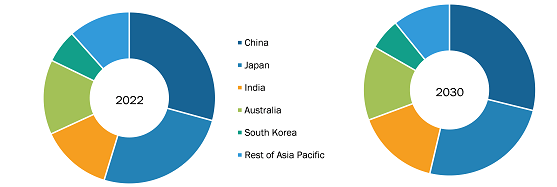Technetium-99m & Tc-97m Segment to Account for Largest Share in Radioactive Tracer Market During 2022–2030
According to our latest study on “Radioactive Tracer Market Forecast to 2030 – COVID-19 Impact and Analysis – by Test Type, Tracer Type, Application, End User, and Global," the market is expected to grow from US$ 14,675.73 million in 2022 to US$ 54,296.57 million by 2030; it is expected to grow at a CAGR of 17.8% from 2022 to 2030. The report highlights the key factors driving the market growth and prominent players with their developments in the market.
Radioactive Tracer Market, by Region, 2022 (%)
Radioactive Tracer Market Size and Forecast to 2030 - Global Analysis by Tracer Type [Technetium-99m & Tc-97m, Iodine-131, Iron-59, Lutetium-171, Rubidium (Rb-82) Chloride & Ammonia (N-13), Scandium-46, Seaborgium-269, Hassium-269, Gallium Citrate Ga 67, Prostate-Specific Membrane Antigen (PSMA) (Ga-68), FDDNP (F-18) & FDOPA (F-18), Phosphorus-32 & Chromium-51, Thallium-201, F-18 FDG, F-18 FAPI, Ga-68 FAPI, F-18 PSMA, DOTATOC/DOTANOC/DOTATATE (Ga-68), and Others], Test Type (PET, SPECT, and Others), Application (Oncology, Pulmonary, Neurology, Cardiology, and Others) End User (Hospitals & Clinics, Diagnostic Centers, Academic & Research Institutes, And Others), and Geography
Radioactive Tracer Market Drivers and Trends by 2030
Download Free Sample
Source: The Insight Partners Analysis
Use of Radioactive Tracer in Cancer Diagnostics Boosts Market Growth
Oncology is a significantly developing field in the healthcare sector, as cancer cases are increasing worldwide. According to Institute for Health Metrics and Evaluation (IHME), cancer is the second major cause of death after cardiovascular disorders. The use of advanced materials and drugs in the diagnosis and treatment of cancer has surged with prominent developments in oncology. Radioactive tracer-based imaging is one of the advanced diagnostic methods used to accurately diagnose cancer types, such as prostate cancer, gynecological cancer, and blood-borne cancer. Once injected into the body, these radioactive Tracer attach to the cancer-specific sites, accurately diagnosing the cancer type. Tracer also help determine the cancer development stage, enabling effective treatment and faster recovery in most cases.
PET and SPECT are among the nuclear imaging techniques that use gamma emitters for detecting tumors. As the tumor grows, its uptake of the PET and SPECT conjugate increases over time, which improves contrast due to the presence of nuclear imaging agents. This further leads to blood clearance due to which clear diagnostic images can be generated. The most commonly used radioactive tracer for detecting cancer is F-18 fluorodeoxyglucose (18F-FDG), a compound similar to glucose or sugar. Cancer cells are highly active and need more energy, i.e., extra glucose, than normal cells. Imaging devices such as PET or SPECT detect this energy released by FDG to create an image showing the location of a radioactive tracer in the body. This helps determine the location of cancerous cells in the patient’s body so that the treatment can be tailored according to the type and stage of cancer. Thus, the increasing use of radioactive Tracer in cancer diagnostics is anticipated to drive market expansion during the estimated timeframe.
Rotem Industries Ltd, Abx Advanced Biochemical Compounds Gmbh, Invicro Llc, Cardinal Health Inc, Newcastle University, Novartis Ag, Curium, Blue Earth Diagnostics Limited, General Electric Co, and Iba Radiopharma Solutions are among the leading companies operating in the radioactive Tracer market.
Companies operating in the radioactive Tracer market adopt various organic and inorganic strategies. Organic strategies mainly include product launches and product approvals. Further, acquisitions, collaborations, and partnerships are among the inorganic growth strategies witnessed in the market. These growth strategies allow the market players to expand their businesses and enhance their geographic presence, thereby contributing to the overall market growth. Acquisition and partnership strategies further help the market players strengthen their customer base and expand their product portfolios. A few of the significant developments by key players operating in the radioactive Tracer market are listed below.
- In June 2022, Telix Pharmaceuticals Limited partnered with Invicro LLC to develop an artificial intelligence (AI) platform to accompany Telix’s PSMA-PET imaging agent, Illuccix (kit for the preparation of gallium Ga 68 gozetotide) known as TelixAI™. TelixAI™ seeks to increase the efficiency and reproducibility of clinicians’ imaging assessments using advanced analysis capabilities with an initial focus on prostate cancer.
- In May 2022, ImaginAb Inc. announced an agreement with Invicro LLC to supply clinical doses of ImaginAb’s investigational CD8 ImmunoPET agent for use in clinical trials as part of Invicro’s global core lab imaging service. The agreement also allows Invicro to produce zirconium Zr 89 crefmirlimab for its preclinical offerings.
Contact Us
Phone: +1-646-491-9876
Email Id: sales@theinsightpartners.com